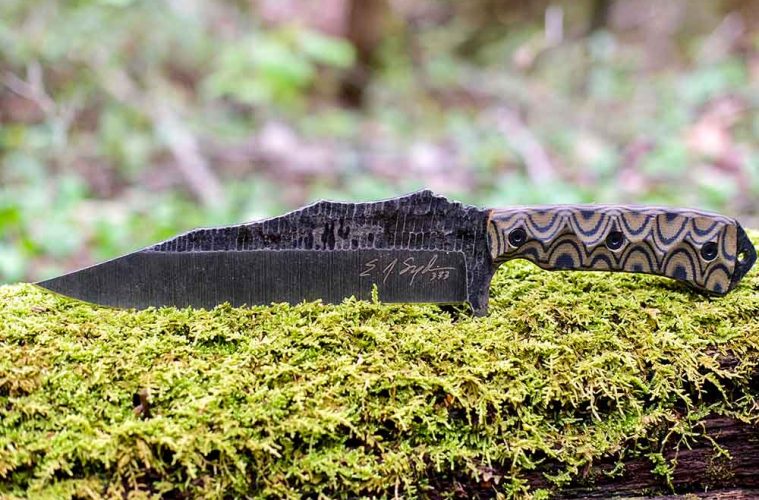THE MOUNTAIN PREDATOR FROM STROUP KNIVES IS AS FIERCE AS IT LOOKS
When a company’s mission statement reads, “To provide you the ONLY knife you need when the world goes to hell,” the hard-use-knife junkie in me sits up and takes notice. A brief look at the Stroup Knives website revealed several interesting blades, all with a distinctive look.
Of course, mission statements are just words, and plenty of knife companies talk the talk. Wanting to see if Stroup Knives could bring the heat or if it was just another internet sensation, I contacted the company owner, Chris Stroup, to find out more about his company and his knives.
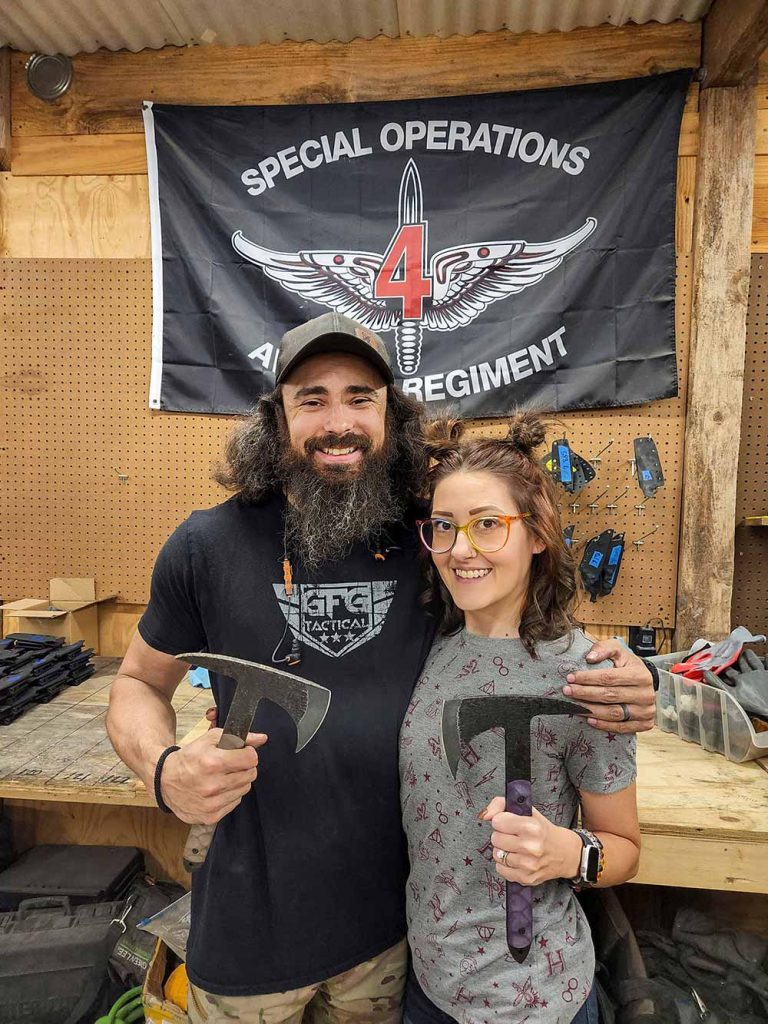
Chris and Meaghan Stroup are the rightfully proud owners of Stroup Knives.
THE MAN BEHIND THE METAL
Chris Stroup grew up in California, hiking and camping with his family and developing a great love for the outdoors along the way. While working as a Communications Specialist in the U.S. Army, Chris developed an interest in knifemaking. He used his downtime to watch videos on the subject and, upon his return home and with help from his son, he made his first knife using simple hand tools. The rest, as they say, is history.
Chris continued to make knives during his time off from active military service. When he returned to duty, he would bring the knives he made to show his teammates, and soon, he had more orders for his knives than he could fill. After a medical retirement from military service and a rocky reentry into civilian life, Chris started making knives full time.
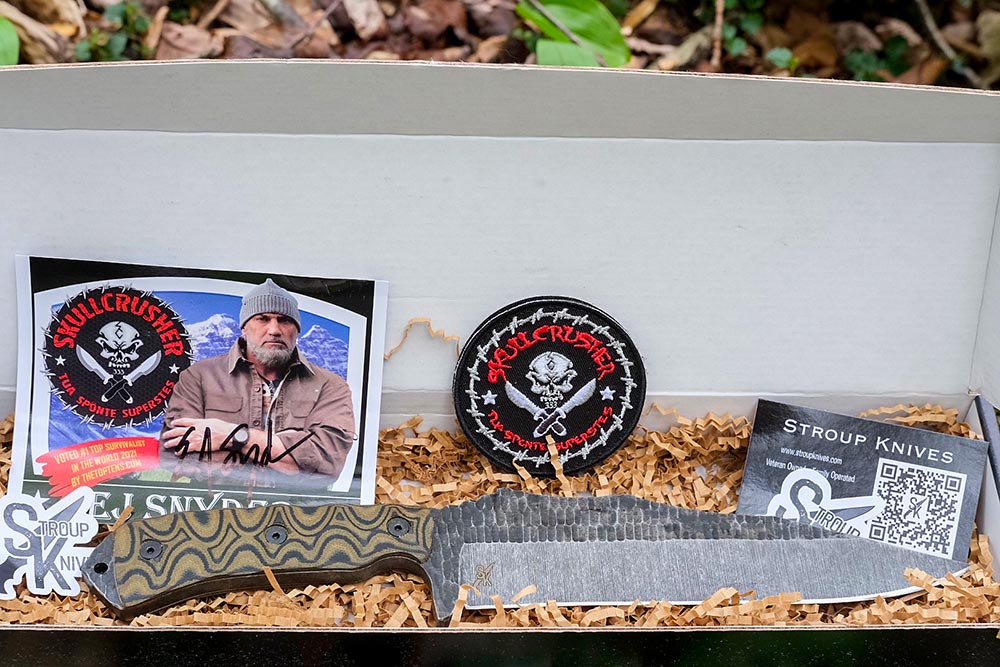
The Mountain Predator was a collaborative design effort between EJ Snyder and Chris Stroup.
From the outset, Chris wanted to use his business to employ retired veterans and law enforcement officers who were struggling to find a purpose beyond their chosen careers. He also wanted to use it as a tool to teach his children the value of hard, purposeful work, finances, relationships, and everything that comes with running a successful small business.
All Stroup knives are made from U.S.-sourced 1095 high-carbon steel, which has a long, proven track record for toughness. It holds an edge well and is easy to maintain in the field. While it might not have the allure of trendy new super steels, its track record speaks for itself. Superb for the outdoorsman, 1095 was Chris’ choice from the start, and he has no plans to deviate from it. Chris takes great pains to ensure that all the materials he uses to construct his knives and sheaths are not only bought from U.S. distributors but are also made in U.S. factories.
Chris is the primary designer of his line of knives, though he made sure that I understood that most of his designs are created with a lot of input from his employees and family. He has also begun designing knives in collaboration with sources outside of his company, which brings us to the subject of this review: the Stroup Knives EJ Snyder Signature Mountain Predator.
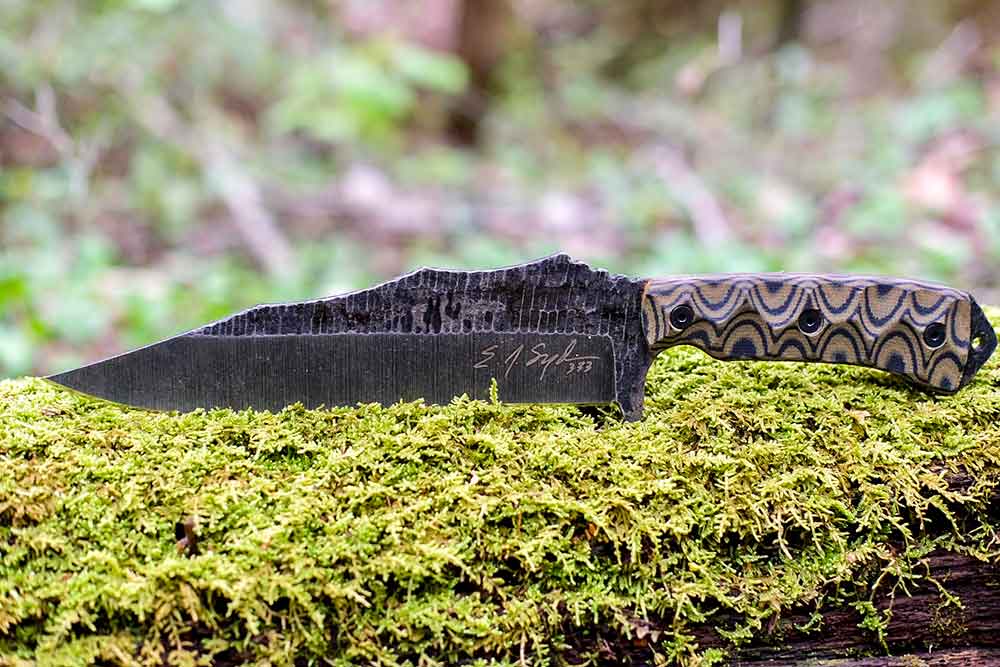
Don’t let the rugged looks of the Mountain Predator fool you. It is precision-made with great attention to detail.
THE MOUNTAIN PREDATOR
I am of the mindset that with the proper set of skills, a big knife can accomplish almost everything that a small knife can, while the reverse is not necessarily true. Not that I don’t prefer small knives for many tasks, but when push comes to shove, I like to have a large knife close at hand.
The Mountain Predator is a collaborative effort between Stroup Knives and EJ Snyder. For those of you who have been living under a rock, EJ Snyder is a larger-than-life TV personality who has appeared on the Discovery Channel hit series “Naked and Afraid” and “Naked and Afraid XL” six times. He hosted one season of “Dual Survival” and was a guest on one episode of “First Man Out” with Ed Stafford.
“…the Mountain Predator is no slouch and will do darn near anything you ask of it.”
In addition to his TV appearances, EJ is also a retired Sergeant Major in the U.S. Army, with multiple combat tours, two Bronze Stars, and a host of other medals and commendations to accompany his long list of training certifications and skill sets. To say that EJ Snyder knows what it takes to survive in a variety of non-permissive environments is a gross understatement. Who better to bring on board to help design a large survival knife?
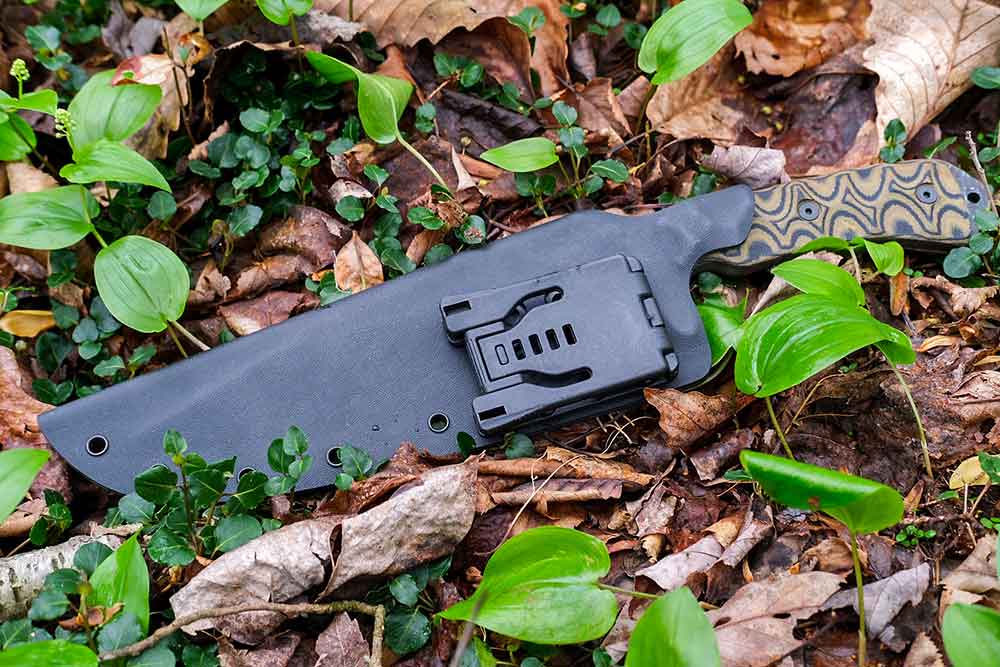
Each Mountain Predator ships with a Kydex sheath and Tek-Lok belt mount.
EJ came to the Stroup Knives shop to meet Chris and his team, and they instantly hit it off. After a lot of discussion, EJ and Chris decided to make a Bowie-style knife, and the Mountain Predator was born. The Bowie knife is iconic in U.S. history and folklore for its ability as a do-everything wilderness tool and combat blade. While many of the stories surrounding the Bowie knife might be “enhanced,” there is no denying that it is a highly capable design and worthy of its reputation.
SHARP DETAILS
The Mountain Predator has a 7½-inch blade with a 6-inch multi-position handle. The blade stock is ¼-inch 1095 high-carbon steel with a ¾-height high saber grind. The blade’s edge is primarily straight with a gentle sweep ending in the reinforced tip. While the tip is well-defined and designed for piercing, it is still plenty strong.
Each handle is made from sculpted camo canvas Micarta secured to the tang by three large bolts. The handle places the index finger close to the blade’s centerline. This design provides the benefit of making the knife feel well-balanced and nimble despite its size and eliminates the concern of “riding the blade” during heavy stabbing activities. The pommel end of the tang is exposed to allow for striking and hammering without concern of damage to the G10 scales.
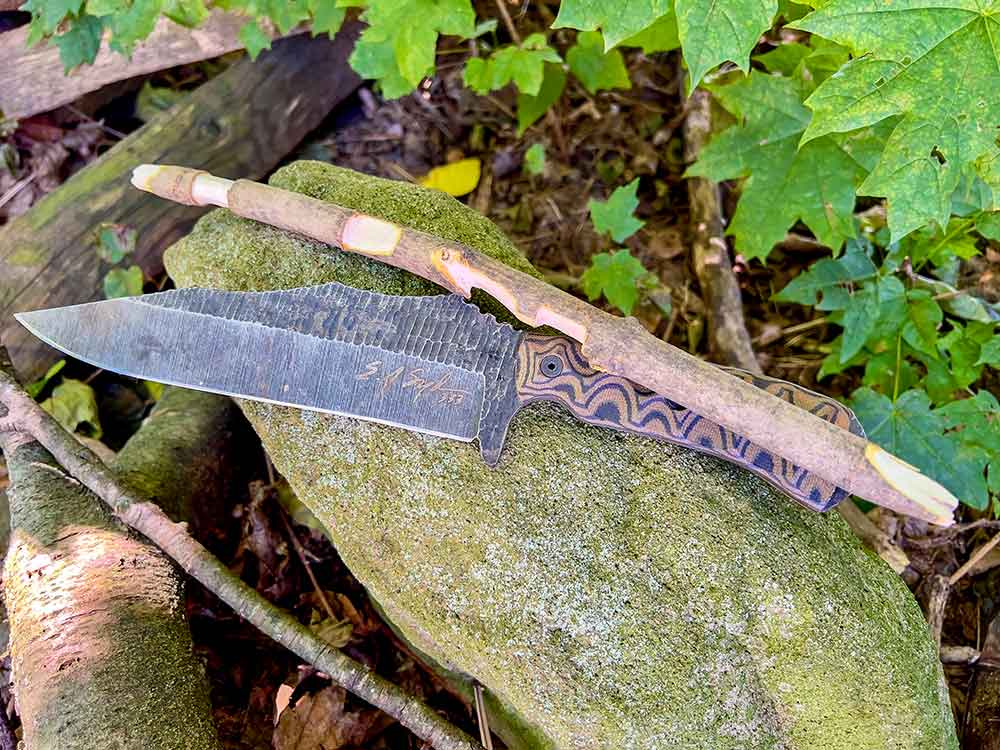
Despite its size, the Mountain Predator has no trouble carving a Try Stick.
IN THE FIELD
When I took the Mountain Predator into the field, I wasn’t sure how I was going to like it. I liked the overall design, but I was concerned that the sculpted handle might cause me some problems. I’ve used knives with heavily scalloped handles in the past and found that I liked their looks much more than I liked their feel. The Mountain Predator quickly put those concerns to rest.
I was confident that the Mountain Predator would perform well as a chopper and wood splitter and wanted to start my field testing with some finer work. One of the first things I do with a new woods knife is to carve a Try Stick. The Try Stick was developed by bushcraft and survival legend Mors Kochanski to serve two purposes. The first is to provide the end user a way to practice a wide variety of cutting and carving techniques. Each cut on the Try Stick is very specific and translates to many wilderness-living skills projects. Some cuts are very simple while others are more complex and intricate.
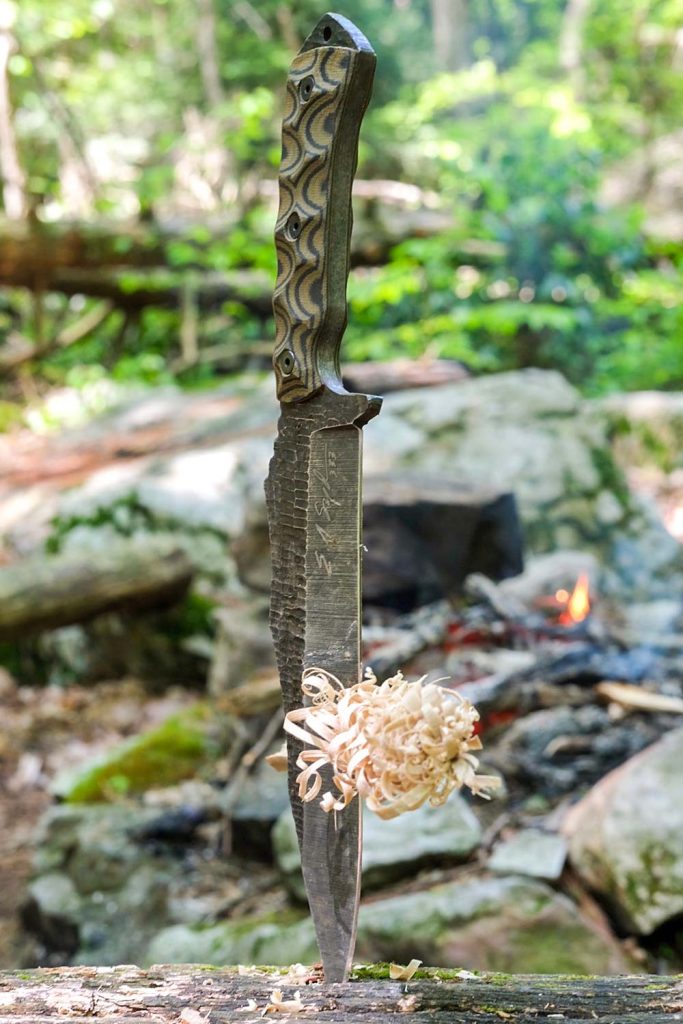
The Mountain Predator makes feather sticks with the best of them.
The second purpose of the Try Stick is to provide a bushcraft/survival instructor a way to gauge a student’s skill and ability with a knife. Having carved them with everything from small pocketknives to large survival knives, and knowing my skill level, I find this to be a great way to judge the abilities of the knife itself.
As I’ve said, the Mountain Predator’s feel in hand is nimble for a knife this size. It balances at the ricasso, giving the blade a very neutral feel. The handle design places the user’s hand close to the ricasso and edge, which is a real boon for doing finer, detailed work. The overall design of the knife allowed me the latitude to move my hand around on the grip and up onto the flats of the blade to take full advantage of the edge, especially when making some of the more detail-oriented cuts. At no time did the handle cause me any discomfort.
“A few minutes of stropping at the end of the day had the hair popping off of my arm.”
Another limiting factor that can affect the cutting efficiency of a knife is the edge geometry. The Mountain Predator is delivered with a ¾-height saber grind that is designed for toughness and endurance. Some knives with these design parameters have the cutting characteristics of a sharpened pry bar. Fortunately, this is not the case with the Mountain Predator. While it does not have as acute of an edge as a small Scandinavian carving knife, it cuts extremely well for a large knife intended for hard use. While my preference for fine carving knives will always be small, light knives with thin, sharp edges, the Mountain Predator is no slouch and will do darn near anything you ask of it.
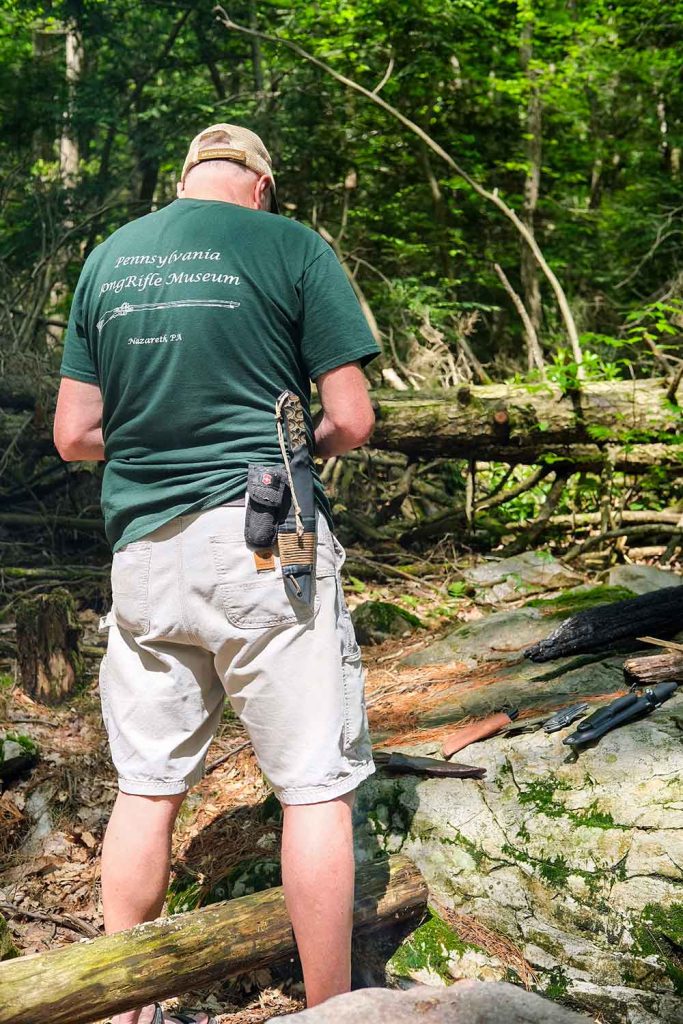
: Survival expert Ed Arnold owns and carries a Mountain Predator. Ed knows his knives and his endorsement carries a great deal of weight among those in-the-know.
THE FINER THINGS
Another fine carving task that I use to evaluate a field knife is its ability to make feather sticks. Fire making is a seminal skill for any woodsman, and the ability to create tinder from a piece of wood is a comforting and potentially life-saving skill to have.
When making feather sticks with a small knife, I will hold the knife in my hand and draw the blade across the wood. This can be done with larger knives, but their weight and size often make this a tiring experience.
My preferred technique when using large knives like the Mountain Predator is to drive the tip into a log or other heavy, stable piece of wood and draw the stick across the knife to make feathers. I was able to easily make feather sticks using both methods, though the second was much more enjoyable.
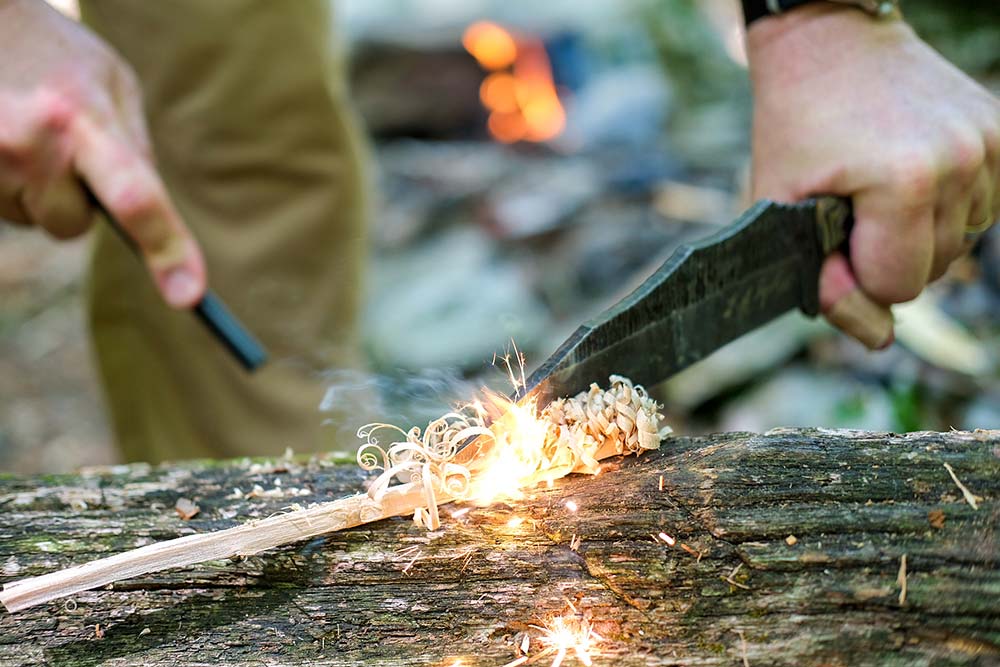
The front portion of the spine is squared off and makes a great fire-steel striker.
HITTING IT HARD
With the fine carving tasks out of the way, I used the Mountain Predator for heavier work. The reasonably thin edge of the blade makes it an outstanding chopper. The blade bit deep into both green and dead wood, easily limbing trees and felling small saplings.
Predictably, the Mountain Predator also excelled at batoning wood. The edge geometry ensured that the blade drove deeply into larger logs and the ¼-inch-thick blade stock wedged the logs apart with ease.
While the blade’s performance was fairly predictable, it surprised me how comfortable the handle was. While it is heavily scalloped, it is done so with care and attention to detail. I experienced no hotspots, even while chopping. The handle remained stable in my hand and showed no tendency to twist or slip.
Between the chopping and batoning, I expected to see some small nicks or impacts on the edge. There were none. The blade felt nearly as sharp at the end of my testing as it did at the outset. A few minutes of stropping at the end of the day had the hair popping off of my arm. Stroup Knives has its heat treat dialed in!
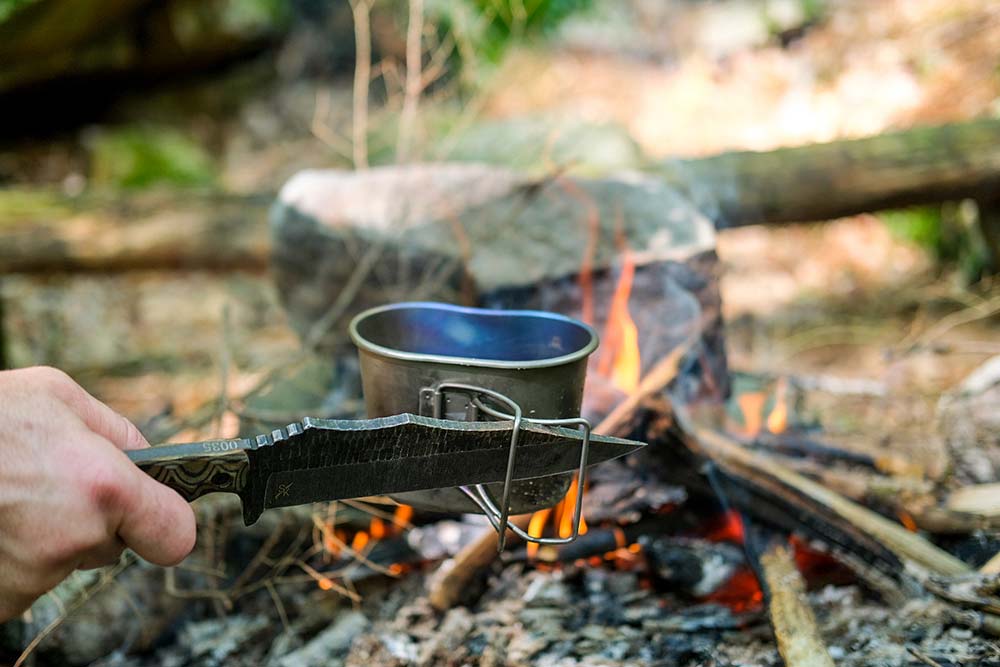
Big knives have some definite advantages over small knives. Being able to reach into a fire is one of them!
BIGGER IS SOMETIMES BETTER
I understand that big knives aren’t for everyone. For those of us who like them, and especially those of us who appreciate the Bowie design, the Mountain Predator is hard to beat. It is truly a jack-of-all-trades and a serious woodsman’s tool. I think our mountain-man ancestors would have been proud to include a Mountain Predator in their kits.
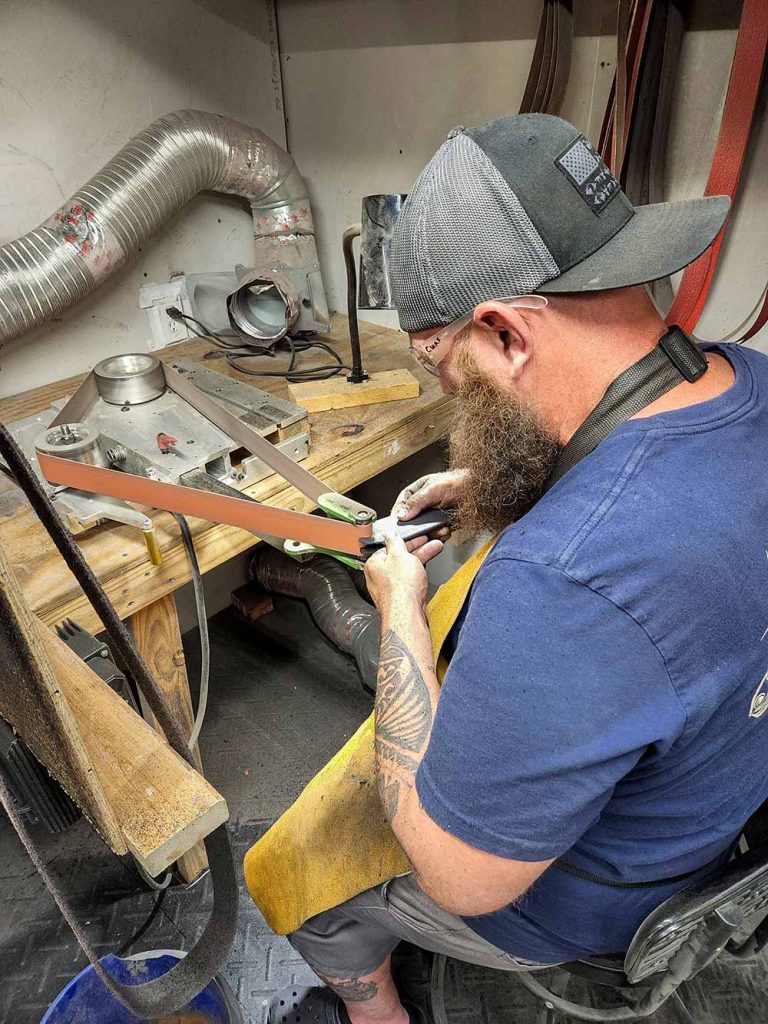
All Stroup knives are supplied with handmade, hand-fitted Kydex sheaths.
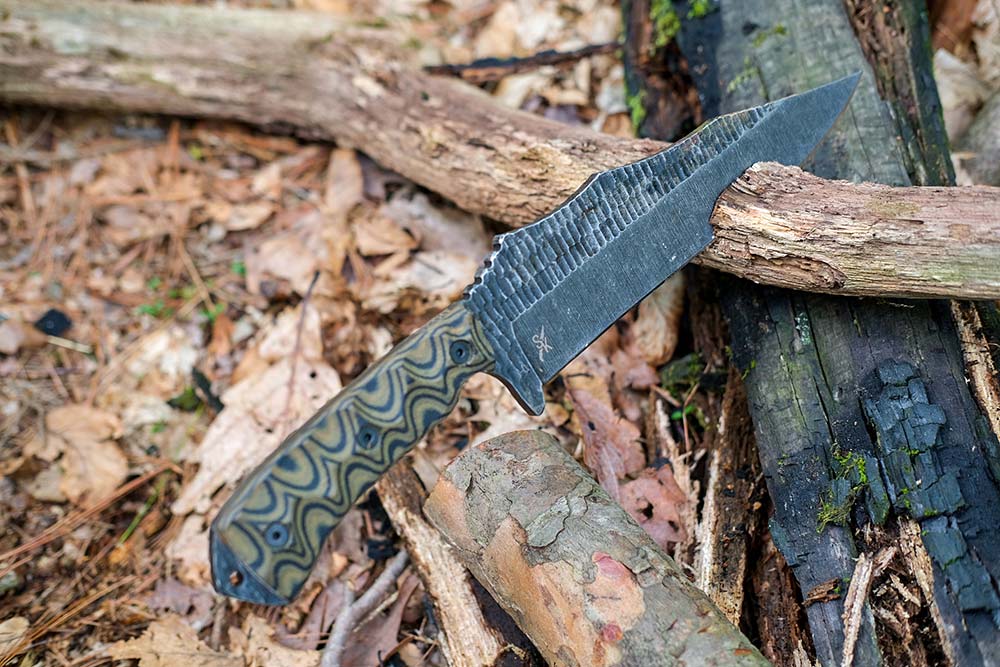
The high grind on the Mountain Predator ensures that it bites deep into wood.
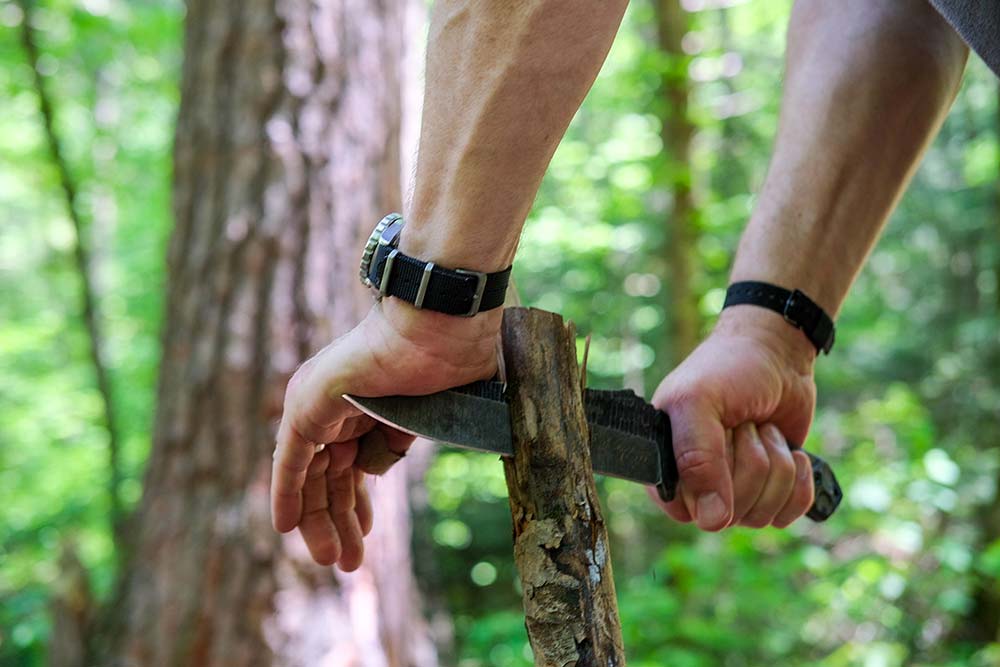
Its ¼-inch-thick blade makes the Mountain Predator a great choice for splitting wood.
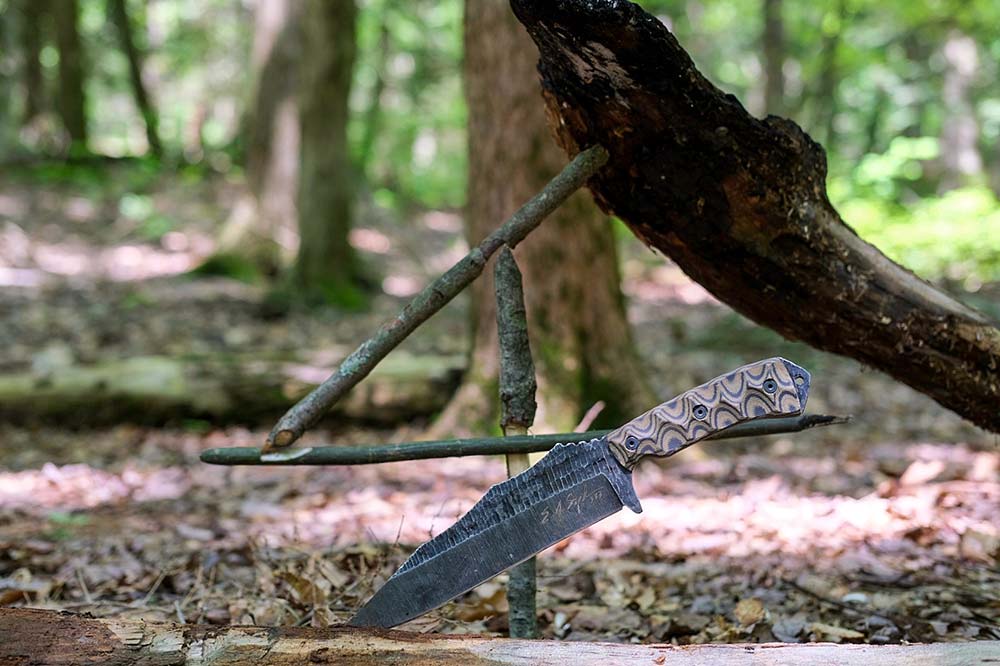
Every good survival knife should be able to carve primitive traps.
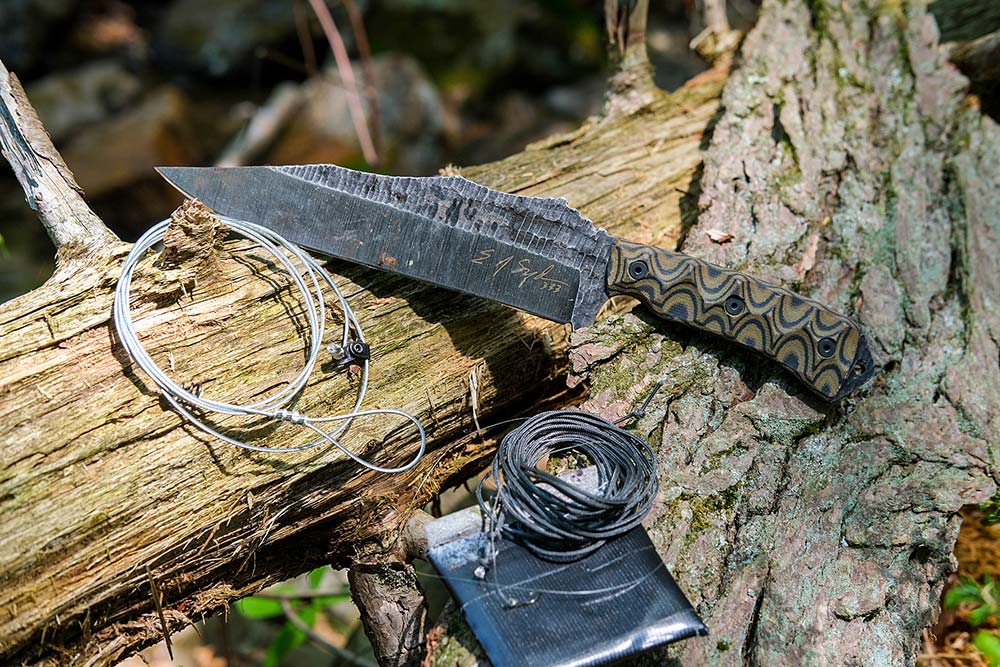
: As was the Bowie knife of our frontiersmen predecessors, the Mountain Predator is a perfect match for this fishing and snaring kit.
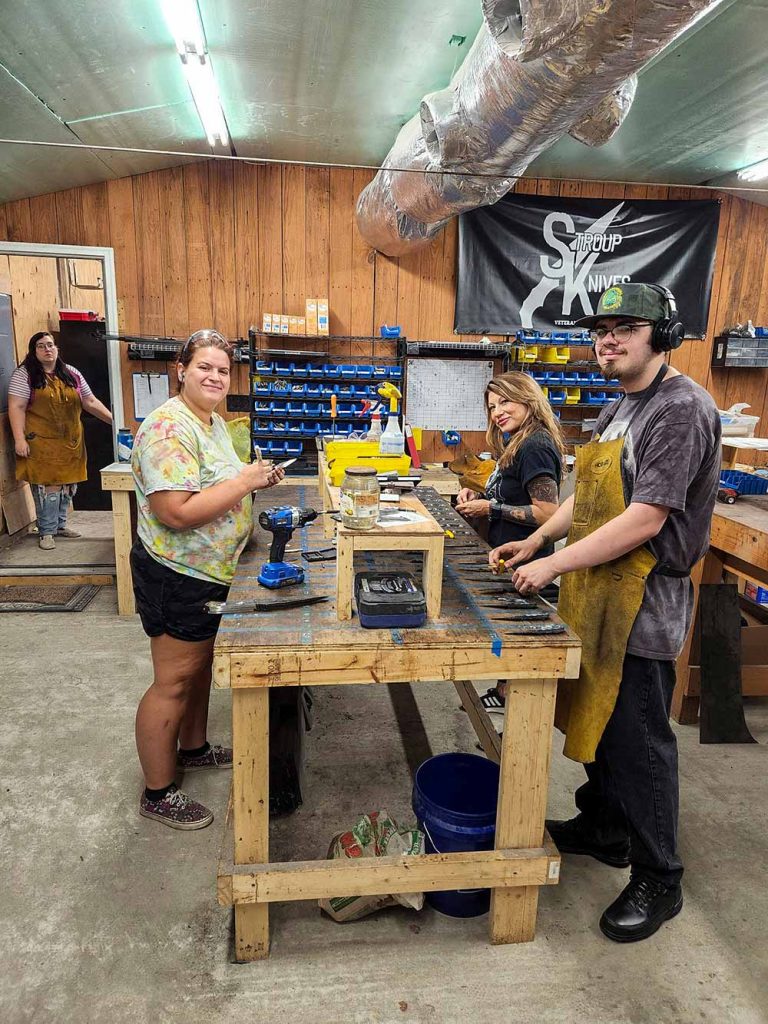
Stroup Knives employees preparing to fit handles to blades.
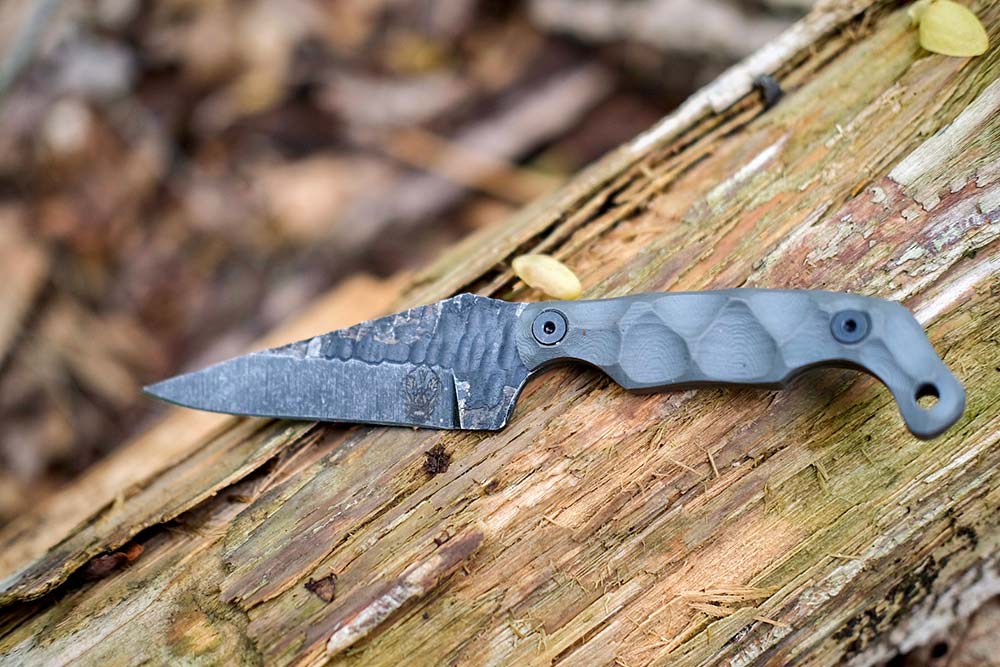
The Bravo 5 is a compact powerhouse of a blade.
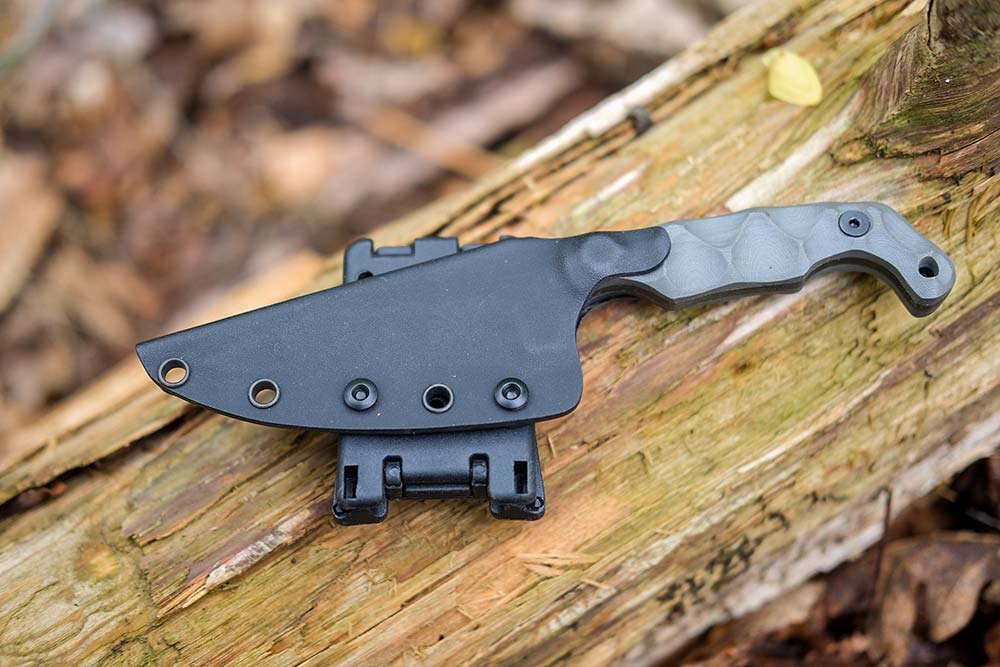
Each Bravo 5 is delivered with a taco-style Kydex sheath and mini Tek-Lok belt clip.
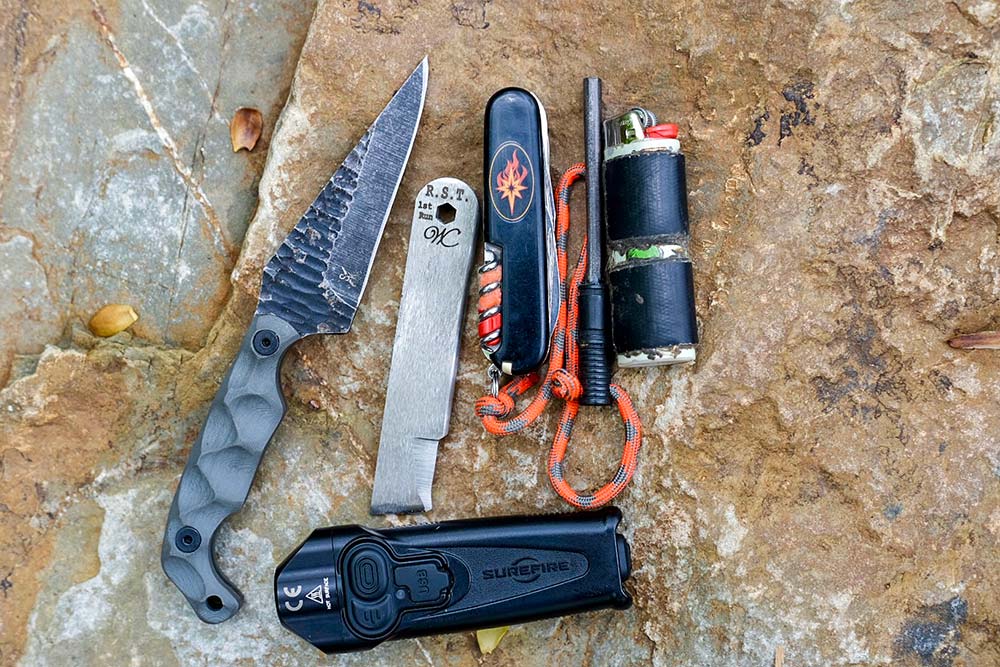
The Bravo 5 has been the author’s choice for an EDC knife since receiving it.
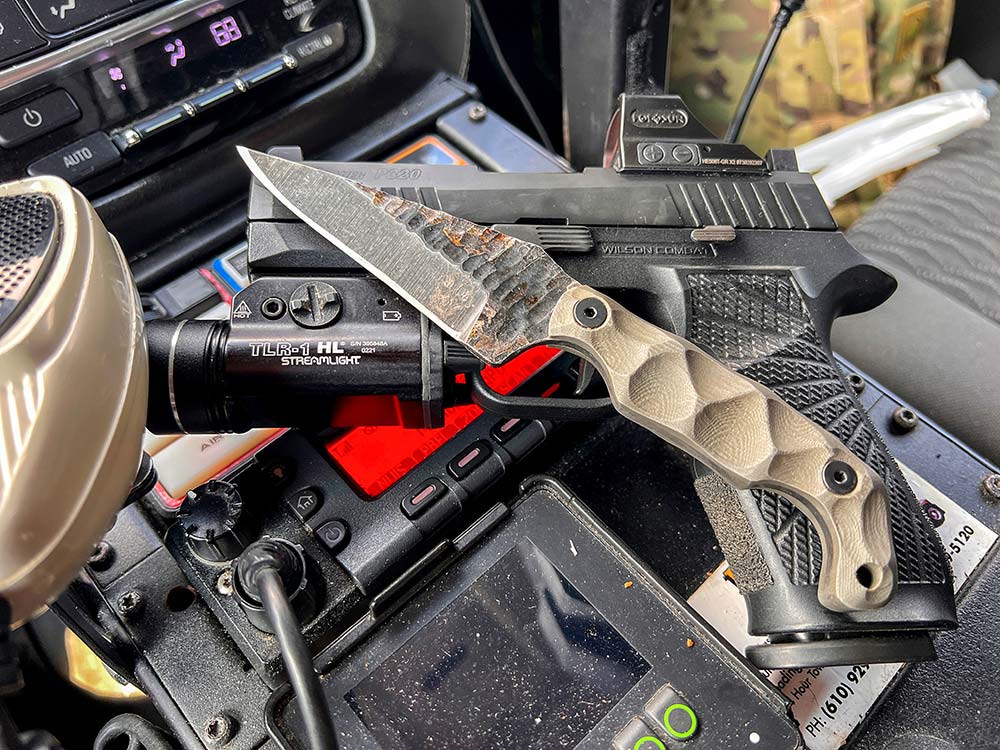
The Bravo 5 also doubles as the author’s preferred work knife.
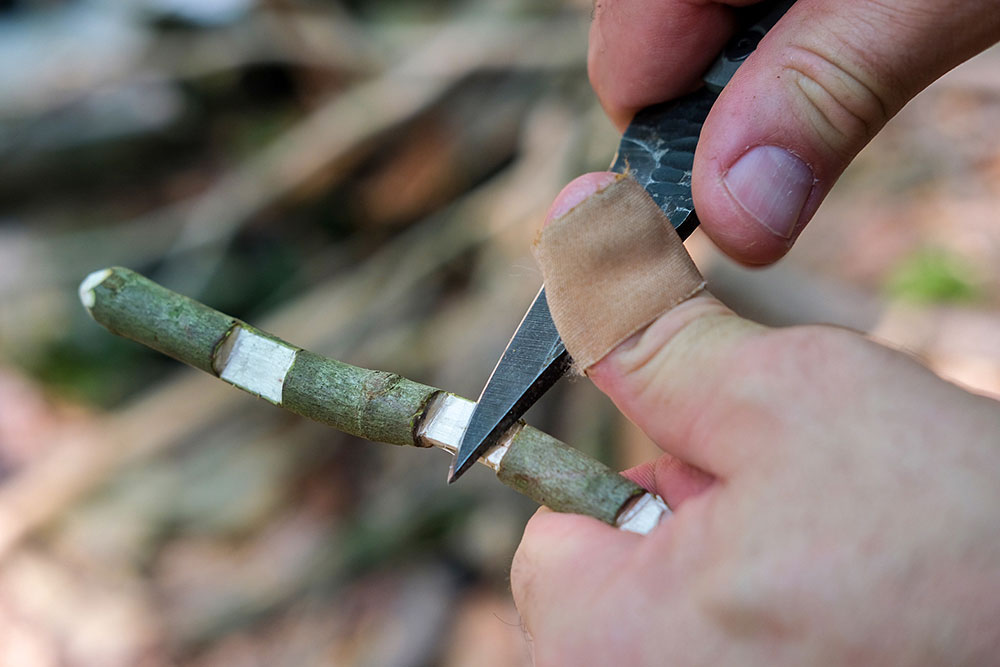
: Don’t let the radical-looking design of the handle fool you. The Bravo 5 is extremely comfortable to hold and use.
BRAVO 5—ANOTHER KNIFE TO CONSIDER
Like the Mountain Predator, the Bravo 5 is a collaborative effort. The blade was co-designed with Justin Melnick. Justin is a retired Indiana police officer, K-9 handler, combat photographer, and actor in the hit CBS series “SEAL Team.”
Justin discovered Stroup Knives on Instagram and, after learning about the company, reached out to discuss designing a blade. As a result, the Bravo 5 was born.
The Bravo 5 was made to be a multipurpose, do-everything blade. The design lends itself well to piercing and slicing tasks, making it a tremendous EDC knife.
The 3½-inch 1095 drop-point blade is mated to a 4¼-inch handle with contoured G10 scales. The blade is delivered with a minimalist, taco-style Kydex sheath that adapts well to a variety of carry options.
Like with the Mountain Predator, I was primarily concerned about handle comfort. It looked pretty radical on the website. And also like with the Mountain Predator, those concerns were unfounded. Despite its unique design, the handle is extremely comfortable in a variety of grips.
While I have used it in the woods to good effect, the Bravo 5 has replaced my EDC folding knife both in my everyday life as well as at work. I replaced the included Tek-Lok belt clip with a low profile Ulticlip to facilitate pocket carry. Whether I’m wearing running shorts or a pair of khakis, the sheath clips into my strong side pocket, keeping the blade low-profile and ready for immediate access.
To date, I’ve used the Bravo 5 for everything from carving wood to opening cases of ammo at the range, opening letters and boxes at home, food prep, and a wide variety of homesteading chores. Edge retention has been excellent, with only occasional stropping needed to touch it up. That wild-looking handle fits my hand like it was made for me and provides an extremely secure purchase on the blade.
I’ve attempted to carry many small fixed blades as EDC replacements to a folding knife and have always reverted to the folder for convenience. The Bravo 5 is still riding in my pocket. I like the way it carries, I like the way it feels in the hand, and I love the performance it provides.
If you are looking for a compact fixed blade to add to your rotation, the Bravo 5 comes with my highest recommendation. As a bonus, 10% of the proceeds from the sale of every Bravo 5 goes to the Special Operations Wounded Warrior charity foundation.
SPECS
Stroup Knives EJ Synder Signature Mountain Predator
Total Length: 13½ inches
Blade Length: 7½ inches
Blade Steel: ¼-inch 1095 high-carbon steel
Handle: Camo canvas Micarta
Sheath: Custom-formed Kydex
Weight: 37 ounces
Origin: USA
MSRP: $399
A version of this article first appeared in the December 2022 print issue of Knives Illustrated.

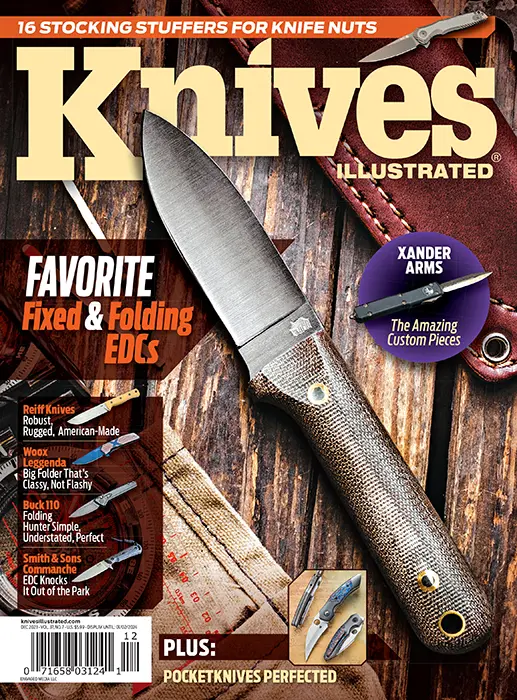 Subscribe / Back Issues
Subscribe / Back Issues